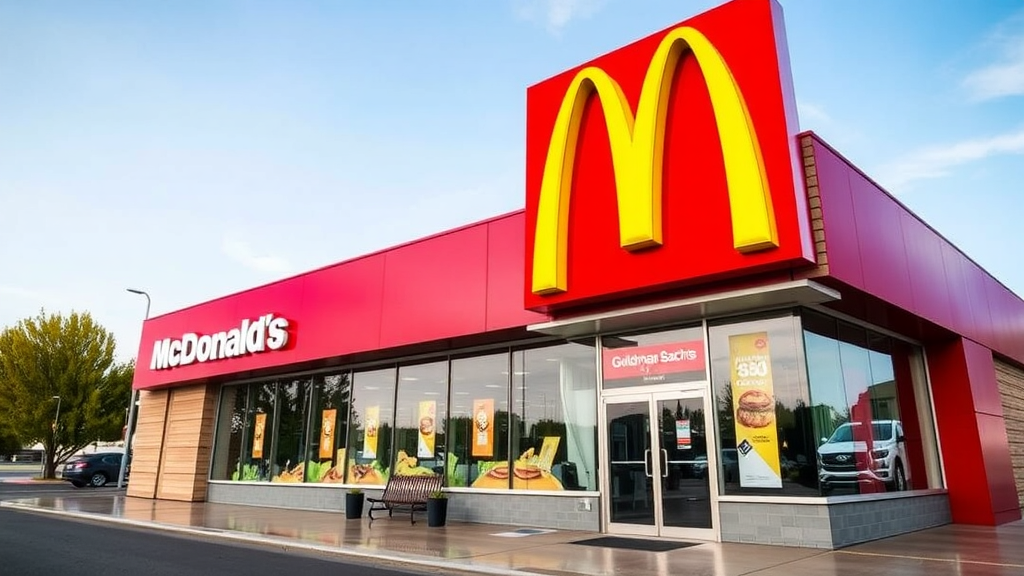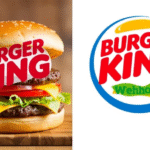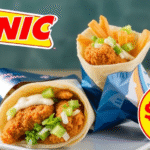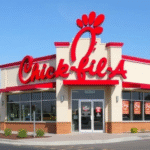Goldman Sachs Turns Bullish on McDonald’s Thanks to Value-Meal Surge
In recent market analysis, Goldman Sachs has displayed a positive shift in perspective regarding McDonald’s, largely attributing this bullish stance to the surge in value meal offerings. This pivot comes at a time when consumers are consciously seeking more affordable dining options amid rising economic pressures. McDonald’s, a stalwart in the fast-food industry, has capitalized on this trend, positioning itself as a go-to option for budget-conscious diners.
McDonald’s value meal strategy has not only attracted a steady stream of customers but has also increased overall sales. Amid inflation and shifting consumer preferences, the fast-food giant has effectively catered to the need for cost-effective meal choices. But what are the specific elements that have led Goldman Sachs to reassess their outlook on McDonald’s?
Understanding the Value-Meal Trend
The value meal concept isn’t new, but its importance has surged. Consumers today are more skilled at budgeting, and many are cutting back on dining out. Fast food, particularly through value meals, provides quick access to affordable meals. This is compelling for busy individuals and families looking to save time and money. Here are the key reasons driving this trend:
- **Affordability**: Value meals offer significant savings compared to individual menu items, making them attractive during economic uncertainty.
- **Convenience**: The fast-food model ensures quick service, making it ideal for those with on-the-go lifestyles.
- **Variety**: McDonald’s extensive menu allows customers to choose from multiple options, including healthier alternatives that appeal to a broader audience.
The Financial Upsurge
Goldman Sachs observed that following enhancements in value meal options, McDonald’s reported increased foot traffic and higher average ticket sizes. According to their data, the introduction of new and enticing value meals rejuvenated interest in McDonald’s offerings, promoting brand loyalty. This led to a noticeable uptick in revenues and a boost in customer engagement.
In the second quarter of 2023, McDonald’s recorded a 5% increase in global sales, outperforming many competitors in the fast-food market. This growth reflects how effectively the company has focused its strategies on maximizing consumer appeal during challenging economic conditions.
Analyzing Stock Performance
Reflecting their new outlook, Goldman Sachs upgraded their stock rating on McDonald’s, expressing confidence in its financial performance and future growth trajectory. Here are some insights:
| Metric | Current Value | Previous Value |
|---|---|---|
| Stock Rating | Buy | Hold |
| Estimated Earnings Growth | 8% | 5% |
| Revenue Growth | 5% | 3% |
This shift indicates a belief in McDonald’s ability to maintain momentum as it continues to innovate and expand its value meal offerings. With consumers’ preference leaning heavily towards affordability, the fast-food chain is well-positioned for sustained success.
Looking Ahead: Market Potential
McDonald’s commitment to enhancing its menu with enticing value meals signifies more than just a trend; it indicates market potential. Experts suggest that the company could further adapt its offerings to include localized value meals that cater to regional tastes. This versatility can enhance customer loyalty and attract more diverse demographics.
Moreover, as golden arches continue to shine even amidst economic trials, ongoing focus on promotions and value-centric marketing can keep McDonald’s at the forefront of the fast-food landscape. In a crowded marketplace, maintaining relevance is crucial, and McDonald’s appears to have found a successful formula through its value meal focus.
For further insights on McDonald’s strategies and the ongoing economic landscape, you can visit MarketWatch or Bloomberg. These sources provide depth and analysis on current trends influencing the fast-food industry.
As Goldman Sachs turns bullish on McDonald’s, the surge in value meals stands as a testament to intelligent strategy and consumer adaptability in a shifting market. The combination of affordability, convenience, and variety positions McDonald’s favorably for the future.
The Impact of Value Meals on Fast Food Sales
The fast-food industry has seen considerable changes over the years. One factor gaining significant traction is the rising popularity of value meals. These meal bundles often offer a combination of food and drink at a lower price point, making fast food more appealing to budget-conscious consumers. As fast-food chains adapt to shifting consumer preferences, the impact of value meals on their sales has become immensely significant.
When it comes to understanding consumer behavior, it’s clear that a focus on value can drive sales. A value meal typically includes an entree, side, and drink, allowing customers to spend less while getting a fuller meal. This format appeals to families and individuals alike. For example:
- Convenience: Value meals simplify the ordering process. Customers can quickly pick a meal without needing to add items separately.
- Affordability: Many consumers find value meals to be budget-friendly, promoting orders that might not happen for a single item.
- Increased Variety: These meals often provide consumers with a larger selection of items to choose from.
Beyond individual consumers, companies benefit from value meals in several ways. One key advantage is the increase in overall sales volume. By bundling items together, companies can encourage customers to spend more overall, increasing their profit margins.
Furthermore, value meals help mitigate competition. With many people looking for quick, affordable meal options, chains that offer compelling value meals can attract customers who might otherwise choose a competitor. Research shows that customers who order value meals are likely to return over time, contributing to a fast-food chain’s long-term growth. The consistency of value meals can foster brand loyalty, especially in highly competitive markets.
Moreover, seasonal or limited-time value meal offers can create excitement and urgency among consumers. When new items are introduced as part of a value meal, it can lead to increased sales as patrons rush to try the new offerings. For instance, McDonald’s has frequently introduced limited-time value meals that tap into trends or local preferences, enticing customers with fresh options while retaining the comfort of familiar items.
It’s also essential to consider the financial implications for fast-food companies. Implementing value meals can require careful planning to ensure that the pricing strategy aligns with cost management. However, many chains report that the increase in traffic often outweighs the lower price point per meal. This balance between price and volume is critical for success.
Here is a simplified table showing some popular fast-food chains and their value meal offerings:
| Fast-Food Chain | Signature Value Meal | Average Price |
|---|---|---|
| McDonald’s | Big Mac Meal | $8.49 |
| Burger King | Whopper Meal | $7.99 |
| Wendy’s | 4 for $4 Meal | $4.00 |
| Taco Bell | Cravings Value Menu | $5.00 |
As companies continue to innovate their value meal offerings, they can use consumer feedback to tailor their menus. Surveys and customer interactions can provide valuable insights into what people want. Fast-food chains that pay attention to these details can better adapt their menu to current trends, keeping customers engaged and satisfied.
Furthermore, the role of social media cannot be overlooked. Many brands are leveraging platforms like Instagram and Twitter to promote their value meals and engage with customers. This marketing strategy not only informs potential customers about great deals but also builds community and excitement around the brand.
The impact of value meals on fast food sales is profound. Chains that embrace this model can effectively connect with consumers on multiple levels—saving them money, time, and delivering variety. By continuously evolving their value meal options and strategies, fast-food brands can ensure they remain competitive in an ever-changing marketplace.
For those interested in further exploring the dynamics of value meals in fast food, the following resources may be beneficial: QSR Magazine and Nation’s Restaurant News.
Market Trends: Why Consumers are Choosing Value Meals
In recent months, a noticeable shift in consumer behavior has emerged, focusing on value meals. This change is evident as people seek affordable options that offer both quality and quantity. Several factors contribute to this trend, which has not gone unnoticed by large corporations. Major financial institutions like Goldman Sachs have begun to take a bullish stance on companies like McDonald’s as a clear indication of this shift.
Consumers are living in an increasingly cost-sensitive world, and value meals are appealing for many reasons:
- Affordability: Value meals typically offer larger portions at a lower price compared to individual items. Customers appreciate the savings that come from selecting a meal deal, making this option economically attractive.
- Convenience: Fast-food restaurants excel in providing quick-service options, ideal for busy lifestyles. With value meals, consumers can enjoy a complete meal without extensive wait times or complicated decisions.
- Variety: Many value meal options include a selection of different items, allowing customers to try various tastes in one go. This variety helps satisfy diverse cravings while remaining budget-friendly.
This trend towards value meals is not merely about saving money. There is a psychological aspect at play, too. The perception of getting a good deal brings a sense of satisfaction. When consumers believe they are making smart financial decisions, it enhances their overall dining experience.
Recent reports show a spike in sales for companies offering value meal options. According to data analyzed by market researchers, places like McDonald’s have seen a particular surge in value meal orders, leading to robust financial performances.
| Company | Q2 Sales Growth (%) | Value Meal Focus |
|---|---|---|
| McDonald’s | 15 | Yes |
| Burger King | 10 | Yes |
| Wendy’s | 8 | No |
Notably, McDonald’s embraced this trend by launching new value meal options tailored to customer preferences. Their commitment to providing affordable meals culminated in favorable market reactions, prompting analysts like Goldman Sachs to express optimism about the brand’s growth trajectory. As more consumers favor economic options, businesses unable to adapt may find themselves lagging behind.
Another compelling factor is the shift in consumer priorities. With rising inflation and economic uncertainty, many individuals are re-evaluating their spending habits. Fast-casual dining and traditional sit-down restaurants are seeing changes as people opt for faster, budget-friendly meals without sacrificing taste. This realignment of preferences highlights the importance of value meals in the current market landscape.
Additionally, many consumers are increasingly health-conscious. While the focus is on cost, many fast-food chains have invested in offering healthier options within their value meals. This combination of nutrition and affordability captures a broader audience and sets brands apart from their competitors.
Understanding the generational differences in dining behaviors is also crucial. Younger consumers tend to prioritize experiences. However, they are also savvy shoppers who appreciate a good value. This demographic trend plays into value meals’ appeal, as they provide an accessible way to enjoy meals with friends without breaking the bank.
The rise in mobile ordering and delivery services has also had an impact. Customers are often prompted by time constraints, leading them to prioritize quick, affordable meals that can be conveniently ordered and delivered to their location. Many fast-food brands are strategically designing their value meal offerings to be easily accessible through apps and online platforms, thereby streamlining the ordering process.
Fast-food investment strategy looks promising for companies that prioritize value meals. Read more about this trend on sources such as Reuters and CNBC. By shifting focus and adapting to consumer desires, companies will solidify their market positions, continuing to sustain long-term growth.
As consumers actively seek more economical options, businesses that respond to these needs stand to benefit significantly in the evolving landscape of the food industry. The bullish stance on McDonald’s signifies a broader trend that is firmly rooted in the present economic situation. As value meals rise in popularity, one thing is certain: the market will remain attentive to shifting consumer patterns as we move forward.
McDonald’s Response to Changing Consumer Preferences
In recent years, McDonald’s has shown an impressive ability to adapt to changing consumer preferences. From evolving dietary trends to a growing demand for convenience, the fast-food giant is navigating the complexities of modern eating habits with a keen eye for innovation and responsiveness.
The rise of health-conscious eating is one of the significant shifts influencing McDonald’s strategy. As consumers become more aware of nutrition, they are demanding healthier options. McDonald’s has responded by expanding its menu to include salads, fruit, and low-calorie alternatives. Research indicates that this shift has not only attracted health-focused customers but has also rejuvenated its brand image in a crowded fast-food market.
Additionally, the growing trend of plant-based diets has become impossible to ignore. Many people are seeking meat alternatives, either for health reasons or ethical concerns. In a proactive move, McDonald’s introduced the McPlant burger in select markets, allowing it to tap into the vegan and vegetarian customer segments. This adaptation is essential, as studies show that more than 50% of consumers are actively trying to consume less meat.
Convenience has also taken center stage in the fast-food industry. With the rise of mobile ordering and delivery services, McDonald’s has enhanced its digital presence. The launch of the McDonald’s app allows customers to order ahead, choose their preferred pickup method, and even access exclusive deals. This streamlining of the ordering process is crucial, as it caters to the fast-paced lifestyle of today’s consumers. In fact, research has shown that nearly 60% of millennials prefer to order food through apps rather than dining in.
The economic environment has also impacted consumer preferences. During tough economic times, value-driven meals become increasingly important. McDonald’s value meals are designed to cater to those seeking affordable options without compromising on taste. This approach has won over price-sensitive customers who still want a quality dining experience. Recent data shows that McDonald’s value meals see a significant surge in sales during economic downturns, demonstrating the brand’s ability to pivot in response to consumer needs.
Moreover, McDonald’s is keenly aware of the importance of sustainability. Consumers are increasingly concerned about environmental issues and are choosing brands that show a commitment to sustainable practices. McDonald’s has made strides in this area by pledging to source sustainable ingredients and reduce its overall carbon footprint. Initiatives such as using recyclable packaging and reducing plastic waste resonate strongly with eco-conscious diners.
Listening to their customers is central to McDonald’s continued success. Social media platforms provide valuable insights into consumer feedback and preferences. By actively engaging with customers online, McDonald’s can adapt its menu offerings based on real-time data. This inclusion fosters a sense of community and trust, allowing the brand to build stronger relationships with consumers.
As McDonald’s continues to respond to changing consumer preferences, data demonstrates that its agility is a key advantage in the fast-food market. Understanding the balance between convenience, health, value, and sustainability sets McDonald’s apart from competitors.
The brand is not just about hamburgers and fries; it is now about creating a diverse menu that appeals to a broader demographic. As they innovate, the emphasis remains on enhancing customer experience while maintaining affordability and quality.
Here are some significant changes McDonald’s has implemented in response to consumer preferences:
- Healthier Menu Options: Includes salads, fruit, and reduced-calorie items.
- Plant-Based Alternatives: Introduction of the McPlant burger for vegan and vegetarian customers.
- Digital and Mobile Ordering: Enhanced app for convenient ordering and exclusive deals.
- Sustainability Initiatives: Commitment to sustainable sourcing and environmentally friendly practices.
This effective strategy highlights that McDonald’s is not just a restaurant; it is a brand that is conscious of the prevailing trends and consumer preferences. For more insights on McDonald’s innovations and efforts, you may visit McDonald’s Official Website or explore McDonald’s Corporate Site.
Changes in consumer preferences are dynamic and ever-evolving. However, with a keen awareness of these shifts and a commitment to innovation, McDonald’s is well-positioned to thrive in the fast-paced fast-food industry while continuing to meet the needs of its customers.
Financial Analysis: Goldman Sachs’ Predictions for McDonald’s Growth
Goldman Sachs has recently revised its outlook on McDonald’s, turning bullish on the fast-food giant due to a significant surge in demand for value meals. This optimistic forecast comes amidst a brewing competition in the quick-service restaurant sector, but McDonald’s ability to innovate its menu and attract budget-conscious consumers positions the company favorably for growth.
There are several factors contributing to Goldman Sachs’ positive predictions regarding McDonald’s growth:
- Value Meal Popularity: McDonald’s value meals have been a hit during tough economic times, drawing in customers looking for budget-friendly options. These meals are not only affordable but also provide a satisfying dining experience, helping McDonald’s to maintain its customer base.
- Menu Innovations: The introduction of new items and limited-time offers keeps the menu fresh and exciting, encouraging repeat visits. Collaborations with popular brands and seasonal specialties have also proven effective.
- Global Presence: McDonald’s extensive international footprint allows it to tap into various markets simultaneously. This diversification minimizes risks and maximizes growth opportunities, even when one market underperforms.
- Strong Digital Strategy: The company has invested significantly in digital ordering and delivery options, making it easier for consumers to access their favorite meals. McDonald’s app offers deals and incentives that drive customer engagement.
Goldman Sachs points out that consumer preferences have shifted dramatically over the past few years. Many customers are now seeking convenience, affordability, and speed when choosing where to eat. McDonald’s, with its drive-thru capabilities and efficient service, is perfectly positioned to meet these needs.
| Quarter | Revenue (in billions) | Net Income (in billions) | Year-over-Year Growth |
|---|---|---|---|
| Q1 2023 | $5.5 | $1.5 | 10% |
| Q2 2023 | $6.0 | $1.7 | 12% |
| Q3 2023 | $6.3 | $1.8 | 15% |
This table reflects McDonald’s impressive financial performance over the last few quarters, reinforcing Goldman Sachs’ confidence in the brand. The sustained growth in revenue and net income showcases how effectively the company has capitalized on consumer trends.
Moreover, the global fast-food landscape is evolving, with rivals attempting to capture market share through similar value-oriented strategies. However, McDonald’s strong brand loyalty provides a clear competitive advantage. The recent campaign “As Featured In” highlights how it’s connecting with consumers through popular culture, fostering emotional engagement and ramping up sales potential.
Additionally, sustainable practices are becoming increasingly vital to the food industry. McDonald’s efforts towards eco-friendly initiatives, such as sustainable sourcing of ingredients and reducing plastic waste, resonate well with environmentally conscious consumers. This commitment not only aligns with consumer values but also enhances brand perception.
Looking ahead, Goldman Sachs sees multiple avenues for continued growth for McDonald’s. Expanding its footprint in emerging markets, particularly in Asia and Africa, opens up exciting possibilities for the brand. As urbanization increases in these regions, there is a growing demand for quick-service dining options that McDonald’s can fill.
Investors considering McDonald’s as an attractive stock can look at its consistency and adaptability in an ever-changing landscape. They can also take comfort in the company’s strong dividends and share buyback programs, which further spotlight its commitment to shareholders.
Goldman Sachs’ bullish stance on McDonald’s is well-founded. With rising demand for value meals, innovative menus, and a robust digital strategy, McDonald’s is poised not only to meet the current market challenges but also to thrive in the future. For more detailed financial analyses, you may check out McDonald’s Corporate or Goldman Sachs.
Competitive Landscape: McDonald’s vs. Other Fast Food Chains
The fast food industry is a highly competitive landscape where major players such as McDonald’s, Burger King, Taco Bell, and Wendy’s vie for consumer attention and loyalty. Each chain employs unique strategies to capture market share and respond to shifting customer preferences. Notably, McDonald’s recently turned bullish partly due to its successful value meal promotions, indicating its effective approach in standing out against competitors.
Market Positioning
McDonald’s has carved out a significant share of the fast food market, dominating in areas like breakfast and value meals. According to recent reports, approximately 70% of McDonald’s sales come from their core menu. Other chains are also adjusting their offerings to counterthis stronghold:
- Burger King: Focuses on flame-grilled burgers and value-driven promotions, appealing to customers who seek alternatives to McDonald’s signature items.
- Taco Bell: Innovates with menu items like the Crunchwrap Supreme and emphasizes affordability with their value menu.
- Wendy’s: Leverages fresh ingredients and unique offerings, positioning itself as a healthier alternative for fast food enthusiasts.
Consumer Trends
As the fast food sector witnesses an increase in health-conscious consumers, chains are pivoting their strategies to cater to these changing demands. McDonald’s has reinforced its commitment to quality by enhancing ingredient transparency and adding healthier options. This shift mirrors broader trends:
- Demand for plant-based options is rising, prompting many chains to develop vegetarian and vegan items.
- Health and wellness trends influence purchasing decisions, making it essential for fast food chains to provide balanced choices.
- Consumers increasingly desire unique dining experiences, challenging brands to innovate beyond traditional menu items.
Promotional Strategies and Value Meals
Promotions play a pivotal role in attracting customers, especially through value meals. McDonald’s has been successful in this space, experiencing a surge in sales thanks to its strategic value meal offerings. Competitors are scrambling to match this push:
- Burger King has rolled out its 2 for $5 Mix and Match deal, allowing customers to choose from multiple options under a value premise.
- Taco Bell continuously updates its value menu, introducing low-cost items that resonate with budget-conscious consumers.
- Wendy’s promotes its “4 for $4” deals, emphasizing a combination of value and taste to attract diners.
Digital Innovation and Customer Engagement
In today’s digital age, engaging customers through technology is more critical than ever. McDonald’s has made significant strides by enhancing its mobile app capabilities, allowing for online ordering and loyalty rewards. Other chains have similarly embraced digital transformation:
Chain Initiatives:
- Burger King: Implemented mobile ordering and exclusive app promotions to incentivize customers.
- Taco Bell: Created a strong social media presence, encouraging fan interaction and leveraging user-generated content to boost engagement.
- Wendy’s: Utilizes Twitter for witty customer engagement and daily specials, which enhances brand loyalty.
Competitive Challenges
Despite its robust position, McDonald’s must navigate economic challenges, evolving regulations, and fierce competition. Key challenges include:
- Adapting to rising ingredient costs and supply chain disruptions.
- Competing with new fast-casual dining options that appeal to a trendier demographic.
- Responding to increased scrutiny over health impacts and the environmental footprint of fast food.
: A Dynamic Landscape
The fast food industry reflects a dynamic landscape, with each player continuously adapting to prevailing trends and consumer demands. While McDonald’s continues to leverage its strengths through value meals and innovative promotions, other chains are not far behind. As consumers increasingly seek variety and value, the competition will undoubtedly intensify, pushing all brands to innovate and evolve.
For more insights on fast food trends and competitive strategies, consider visiting QSR Magazine and FSR Magazine.
The Future of Fast Food: Innovations in Value Pricing Strategies
The fast food industry is experiencing a seismic shift as restaurants adapt to changing consumer preferences and economic conditions. Brands are now turning to value pricing strategies as a means to attract customers seeking more affordable dining options without compromising on quality or taste. As companies innovate in this space, they are finding unique ways to cater to budget-conscious consumers, which not only fosters loyalty but also drives business growth.
Understanding Value Pricing Strategies
Value pricing strategies focus on offering customers quality meals at lower prices. This involves various methods and promotions that create perceived value for customers. Here are some key components driving these strategies:
- Bundle Offers: Chains are increasingly offering meal bundles that combine popular items at a discounted rate. This not only provides savings for the consumer but encourages them to try more items from the menu.
- Limited-Time Offers: Promotions such as seasonal value meals attract attention and create urgency. They encourage customers to visit the restaurant to take advantage of special pricing.
- Loyalty Programs: Joining a loyalty program can incentivize repeat visits. Customers earn points for every purchase, redeemable for discounts or free items, making dining more affordable over time.
Technological Innovations Reshaping Value Pricing
Technology is playing a pivotal role in shaping how fast food restaurants deliver their value meal strategies. Some noteworthy innovations include:
- Mobile Apps: Many chains have developed mobile applications that enable customers to order ahead, find exclusive app-only deals, and earn loyalty rewards. This convenience enhances value perception.
- Dynamic Pricing: Advanced algorithms allow restaurants to adjust pricing based on demand, time, and day. By employing dynamic pricing, fast food outlets can optimize sales and manage inventory effectively.
- AI-Powered Recommendations: Utilizing artificial intelligence, brands can offer personalized meal recommendations based on your previous orders, creating perceived value by suggesting meals tailored to your taste.
Case Studies in Value Pricing
A few leading fast food giants are paving the way in value pricing innovations:
| Brand | Strategy | Impact |
|---|---|---|
| McDonald’s | Value Meal Bundles | Increased foot traffic during lunch hour. |
| Taco Bell | Cravings Value Menu | Built a loyal customer base among young consumers. |
| Domino’s | Mix and Match Deals | Enhanced sales by encouraging larger orders. |
The Role of Social Media and Influencers
Fast food brands are leveraging social media to promote their value pricing strategies. Engaging content that highlights deals and limited-time offers on platforms like Instagram and TikTok can create buzz and drive traffic.
Moreover, collaborating with influencers allows companies to reach a wider audience. An influencer showcasing a value meal can boost credibility and create desire among their followers. This organic form of marketing has proven effective in pushing customers to dine out more frequently.
The Importance of Customer Feedback
To refine value pricing strategies, restaurant chains must prioritize customer feedback. This information can be gathered from various touchpoints:
- Surveys post-purchase
- Social media interactions and comments
- Loyalty program data on purchasing habits
By analyzing customer preferences, restaurants can fine-tune their offerings to ensure they meet the demands of their clientele. Adjustments based on feedback can reinforce the perception of value, enhancing customer satisfaction and loyalty.
As the competition continues to heat up in the fast food sector, the race to innovate and offer value pricing will be a central theme. For brands to stay relevant and profitable, embracing these strategies and technologies is essential.
For more insights on fast food innovations, check out QSR Magazine and explore other industry trends related to value pricing strategies.
In the ever-evolving landscape of fast food, the emphasis on affordability and value meals is set to remain at the forefront, making it an exciting time for consumers and brands alike.
Key Takeaway:
In recent developments, Goldman Sachs has expressed a bullish sentiment towards McDonald’s, primarily driven by the recent surge in value meal offerings. This is an important shift in the fast-food landscape, and it merits a closer look at the implications for the market and for consumers.
Value meals have been a significant catalyst in boosting sales within the fast food sector. Specifically, McDonald’s strategic focus on introducing more cost-effective meal options has appealed to budget-conscious consumers, especially in uncertain economic times. The trend of prioritizing value has not only solidified McDonald’s standing in the fast food industry but has also prompted a notable increase in foot traffic and overall sales. This shift in consumer behavior reflects a broader market trend, where individuals are increasingly searching for affordable meals without sacrificing quality.
McDonald’s proactive response to changing consumer preferences is integral to its recent success. By rolling out value meals that are not just inexpensive, but also balanced and appealing, McDonald’s is addressing a critical need among its customer base. This strategy has helped the fast-food giant differentiate itself from competitors who may not be focusing as keenly on value pricing or may lack the same brand loyalty.
Goldman Sachs’ financial analysis reinforces a positive outlook for McDonald’s, predicting robust growth driven by these value meal initiatives. Analysts point out that these offerings not only cater to existing customers but also attract new ones who are seeking affordability in dining options. This growth positioning, alongside insights into the competitive landscape with respect to other fast food chains, emphasizes McDonald’s strategic advantage.
Looking ahead, the future of fast food seems to hinge on innovations in value pricing strategies. Companies across the industry are likely to reassess their offerings to remain competitive. However, with Goldman Sachs’ endorsement, McDonald’s is presently in an enviable position to capitalize on the value-meal trend, ensuring it remains a leader in the fast food space while preparing itself for any shifts in consumer demands. Ultimately, the success of McDonald’s value initiatives exemplifies the evolving nature of consumer preferences and the importance of adaptability in the fast food industry.
Conclusion
As Goldman Sachs pivots towards a bullish outlook on McDonald’s, it reflects a significant understanding of market shifts and consumer demands. The surge in popularity of value meals has not only bolstered fast food sales but has also reshaped the way consumers interact with their dining choices. With tight budgets in mind, consumers increasingly turn to value meal options, seeking both affordability and convenience.
McDonald’s has adeptly responded to these changing preferences by enhancing their value meal offerings, ensuring they appeal to cost-conscious diners without sacrificing quality. This strategic pivot not only aligns with current market trends but positions McDonald’s favorably against its competitors, offering an edge in a competitive landscape where price sensitivity is paramount.
Goldman Sachs’ financial analysis suggests significant growth potential for McDonald’s, fueled by these value-driven strategies. Their predictions highlight how adapting to consumer needs can lead to impressive returns, indicating a robust future for the fast-food giant.
As the industry progresses, innovations in value pricing strategies are expected to continue flourishing. This creates a dynamic environment where brands must stay agile and responsive to consumer insights. With McDonald’s leading the charge, the future of fast food will likely revolve around balancing quality with accessibility, ensuring that value remains at the heart of the consumer experience.





Leave a Reply